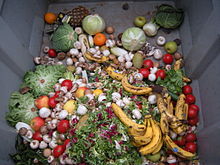Biodegradable waste
| Part of a series on |
| Pollution |
|---|
 |
|
Biodegradable waste includes any organic matter in waste which can be broken down into carbon dioxide, water, methane or simple organic molecules by micro-organisms and other living things by composting, aerobic digestion, anaerobic digestion or similar processes. In waste management, it also includes some inorganic materials which can be decomposed by bacteria. Such materials include gypsum and its products such as plasterboard and other simple organic sulfates which can decompose to yield hydrogen sulphide in anaerobic land-fill conditions.[1] [2]
In domestic waste collection, the scope of biodegradable waste may be narrowed to include only those degradable wastes capable of being handled in the local waste handling facilities.[3]
Biodegradable waste when not handled properly can have an outsized impact on climate change, especially through methane emissions from anaerobic fermentation that produces landfill gas. Other approaches to reducing the impact include reducing the amount of waste produced, such as through reducing food waste. This type of waste is easily degraded by microbes.It mainly includes kitchen waste (spoiled food,fruits, vegetables) ash,soil,dung,parts of plant,etc. This waste is mainly of organic type and is called 'wet solid waste' or 'wet garbage'
Sources[]
Biodegradable waste can be found in municipal solid waste (sometimes called biodegradable municipal waste, or as green waste, food waste, paper waste and biodegradable plastics). Other biodegradable wastes include human waste, manure, sewage, sewage sludge and slaughterhouse waste. In the absence of oxygen, much of this waste will decay to methane by anaerobic digestion.[4]
In the UK, 7.4 million tonnes of biodegradable waste was sent to landfill in 2018 having reduced from 7.8 million tonnes in 2017.[5]
Collection and processing[]
In many parts of the developed world, biodegradable waste is separated from the rest of the waste stream, either by separate curb-side collection or by waste sorting after collection. At the point of collection such waste is often referred to as green waste.[6] Removing such waste from the rest of the waste stream substantially reduces waste volumes for disposal and also allows biodegradable waste to be composted.
Biodegradable waste can be used for composting or a resource for heat, electricity and fuel by means of incineration or anaerobic digestion.[7] Swiss Kompogas and the Danish AIKAN process are examples of anaerobic digestion of biodegradable waste.[8][9] While incineration can recover the most energy, anaerobic digestion plants retain nutrients and make compost for soil amendment and still recover some of the contained energy in the form of biogas. Kompogas produced 27 million Kwh of electricity and biogas in 2009. The oldest of the company's lorries has achieved 1,000,000 kilometers driven with biogas from household waste in the last 15 years.[10]
Climate change impacts[]
Landfill gas[]

Landfill gas is a mix of different gases created by the action of microorganisms within a landfill as they decompose organic waste, including for example, food waste and paper waste. Landfill gas is approximately forty to sixty percent methane, with the remainder being mostly carbon dioxide. Trace amounts of other volatile organic compounds (VOCs) comprise the remainder (<1%). These trace gases include a large array of species, mainly simple hydrocarbons.[11]
Landfill gases have an influence on climate change. The major components are CO2 and methane, both of which are greenhouse gas. Methane in the atmosphere is a far more potent greenhouse gas, with each molecule having twenty-five times the effect of a molecule of carbon dioxide. Methane itself however accounts for less composition of the atmosphere than does carbon dioxide. Landfills are the third-largest source of methane in the US.[12]
Because of the significant negative effects of these gases, regulatory regimes have been set up to monitor landfill gas, reduce the amount of biodegradable content in municipal waste, and to create landfill gas utilization strategies, which include gas flaring or capture for electricity generation.Food waste[]


Food loss and waste is food that is not eaten. The causes of food waste or loss are numerous and occur throughout the food system, during production, processing, distribution, retail and food service sales, and consumption. Overall, about one-third of the world's food is thrown away.[14]
Food loss and waste is a major part of the impact of agriculture on climate change (it amounts to 3.3 billion tons of CO2 emissions annually[15][16]) and other environmental issues. . Moreover, food waste that is not handled or reclaimed properly, i.e. through composting, can have many negative environmental consequences. For example, landfill gas from anaerobic digestion of organic matter is a major source of the greenhouse gas methane, and unreclaimed phosphorus in food waste, leads to further phosphate mining. Moreover, reducing food waste in all parts of the food system is an important part of reducing the environmental impact of agriculture, by reducing the total amount of water, land, and other resources used.
The UN's Sustainable Development Goal Target 12.3 seeks to "halve global per capita food waste at the retail and consumer levels and reduce food losses along production and supply chains, including post-harvest losses" by 2030.[17] Climate change mitigation strategies prominently feature reducing food waste.[18]See also[]
References[]
- ^ "Why can't I put my leftover gyproc/drywall in the garbage?". Recycling Council of British Columbia. 19 September 2008.
- ^ "Fact Sheet: Methane and Hydrogen Sulfide Gases at C&DD Landfills" (PDF). Environmental Protection Agency. State of Ohio, U.S.
- ^ "Organics -Green Bin". Christchurch City Council. Retrieved 19 March 2016.
- ^ CSL London Olympics Waste Review. cslondon.org
- ^ "UK Statistics on Waste" (PDF). March 2019. Retrieved 7 November 2019.
- ^ "Organics - Green Bin". Christchurch City Council. Retrieved 12 March 2016.
- ^ National Non-Food Crops Centre. NNFCC report on Evaluation of Opportunities for Converting Indigenous UK Wastes to Fuels and Energy Archived 20 July 2011 at the Wayback Machine. nnfcc.co.uk
- ^ Recycling chain Archived 2012-03-23 at the Wayback Machine. kompogas-utzenstorf.ch
- ^ AIKAN website. aikantechnology.com
- ^ "Gesundheit, Kraft und Energie für 2002". zuonline.ch. 3 January 2002. Archived from the original on 2 September 2002.
- ^ Hans-Jürgen Ehrig, Hans-Joachim Schneider and Volkmar Gossow "Waste, 7. Deposition" in Ullmann's Encyclopedia of Industrial Chemistry, 2011, Wiley-VCH, Weinheim. doi:10.1002/14356007.o28_o07
- ^ "Methane Emissions". Environmental Protection Agency. 23 December 2015. Retrieved 13 June 2016.
- ^ "The Food Waste Fiasco: You Have to See it to Believe it". Rob Greenfield. 2014-10-06. Retrieved 2020-09-22.
- ^ "UN Calls for Action to End Food Waste Culture - October 4, 2021". Daily News Brief. 2021-10-04. Retrieved 2021-10-04.
- ^ "FAO - News Article: Food wastage: Key facts and figures". www.fao.org. Retrieved 2021-06-07.
- ^ Reuters Staff (2013-09-11). "A third of food is wasted, making it third-biggest carbon emitter, U.N. says". Reuters. Retrieved 2021-06-07.
- ^ United Nations (2017) Resolution adopted by the General Assembly on 6 July 2017, Work of the Statistical Commission pertaining to the 2030 Agenda for Sustainable Development (A/RES/71/313)
- ^ "Reduced Food Waste". Project Drawdown. 2020-02-12. Retrieved 2020-09-19.
- Biodegradable waste management
- Waste
